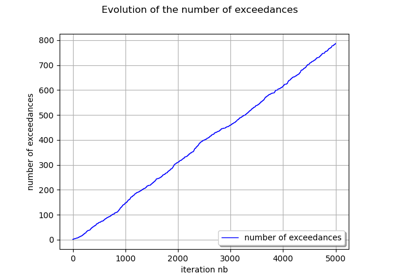IterativeThresholdExceedance¶
- class IterativeThresholdExceedance(*args)¶
Iterative threshold exceedance.
- Parameters:
- dimensionint, default=1
Dimension of the input data
- thresholdValuefloat, default=0.0
Threshold value
See also
Notes
This class iteratively counts the number of threshold exceedances of an iteratively increasing dataset without storing any data in memory.
Examples
>>> import openturns as ot >>> ot.RandomGenerator.SetSeed(0) >>> dim = 5 >>> threshold = 0.5 >>> myThresholdExceedance = ot.IterativeThresholdExceedance(dim, threshold) >>> n = ot.Normal(dim) >>> size = 50
Increment with 50 points:
>>> for i in range(size): ... point = n.getRealization() ... myThresholdExceedance.increment(point) >>> print(myThresholdExceedance.getThresholdExceedance()) [14,14,14,17,12] >>> print(myThresholdExceedance.getIterationNumber()) 50
Increment with one sample of size 50:
>>> sample = n.getSample(size) >>> myThresholdExceedance.increment(sample) >>> print(myThresholdExceedance.getIterationNumber()) 100 >>> print(myThresholdExceedance.getThresholdExceedance()) [38,30,35,27,32]
Methods
Accessor to the object's name.
Get the dimension of the algorithm
getId()Accessor to the object's id.
Get the current iteration of the algorithm
getName()Accessor to the object's name.
Accessor to the object's shadowed id.
Returns the number of threshold exceedances component per component
Returns the value of the threshold
Accessor to the object's visibility state.
hasName()Test if the object is named.
Test if the object has a distinguishable name.
increment(*args)Increment the internal data.
setName(name)Accessor to the object's name.
setShadowedId(id)Accessor to the object's shadowed id.
setVisibility(visible)Accessor to the object's visibility state.
- __init__(*args)¶
- getClassName()¶
Accessor to the object’s name.
- Returns:
- class_namestr
The object class name (object.__class__.__name__).
- getDimension()¶
Get the dimension of the algorithm
- Returns:
- dimensionint
Dimension of the algorithm
- getId()¶
Accessor to the object’s id.
- Returns:
- idint
Internal unique identifier.
- getIterationNumber()¶
Get the current iteration of the algorithm
- Returns:
- iterationint
Current iteration of the algorithm
- getName()¶
Accessor to the object’s name.
- Returns:
- namestr
The name of the object.
- getShadowedId()¶
Accessor to the object’s shadowed id.
- Returns:
- idint
Internal unique identifier.
- getThresholdExceedance()¶
Returns the number of threshold exceedances component per component
- Returns:
- thresholdExceedance
Point current number of threshold exceedances component per component.
- thresholdExceedance
- getThresholdValue()¶
Returns the value of the threshold
- Returns:
- thresholdValuefloat
the value of the threshold.
- getVisibility()¶
Accessor to the object’s visibility state.
- Returns:
- visiblebool
Visibility flag.
- hasName()¶
Test if the object is named.
- Returns:
- hasNamebool
True if the name is not empty.
- hasVisibleName()¶
Test if the object has a distinguishable name.
- Returns:
- hasVisibleNamebool
True if the name is not empty and not the default one.
- increment(*args)¶
Increment the internal data.
- Parameters:
- datasequence of float or 2-d sequence of float
New input point or sample.
- setName(name)¶
Accessor to the object’s name.
- Parameters:
- namestr
The name of the object.
- setShadowedId(id)¶
Accessor to the object’s shadowed id.
- Parameters:
- idint
Internal unique identifier.
- setVisibility(visible)¶
Accessor to the object’s visibility state.
- Parameters:
- visiblebool
Visibility flag.
 OpenTURNS
OpenTURNS
